First Drive: 2016 Smart Fortwo
#1
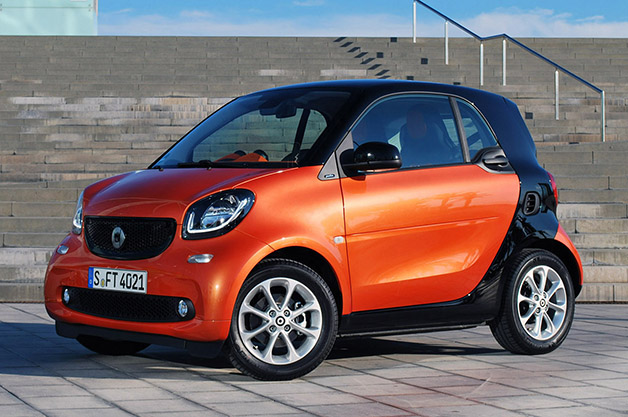
Gallery:
http://www.autoblog.com/photos/2016-...photo-3093518/
In the sixteen years since Daimler first introduced the Smart car, the micro city car market has grown significantly to the extent that the urban-oriented brand doesn't just have more competition to contend with these days than it did in the late 90s; for the first time it has real competition on its hands altogether. In other words, while the Smart Fortwo once had the micro city car market almost entirely to itself, new rivals have emerged to challenge its dominance.
It may be a long time, if ever, before slightly larger contenders like the Scion iQ and Volkswagen Up! catch up to the 1.6-million units Smart has moved since it first hit the market back in 1998, somehow never managing to turn a profit along the way. But the bottom line is that Smart's position in the market is far from assured, especially relying, as it has, on the same architecture for over a decade and a half.
So after strongly hinting at the way forward with a series of show cars, Daimler revealed the all-new Smart Fortwo and its bigger brother, the Forfour, in July ahead of its debut at last month's Paris Motor Show. With both the brand's future and its supremacy in the urban mobility market hanging in the balance, we boarded a flight to Barcelona to see what Daimler had up its short sleeve. What we found was a two-seat city car that's not just a substantial improvement over the model it replaces, but an altogether different beast one which doesn't aspire to be everything to everyone, but just might be what drivers in the world's densest urban cores will need... and little more.
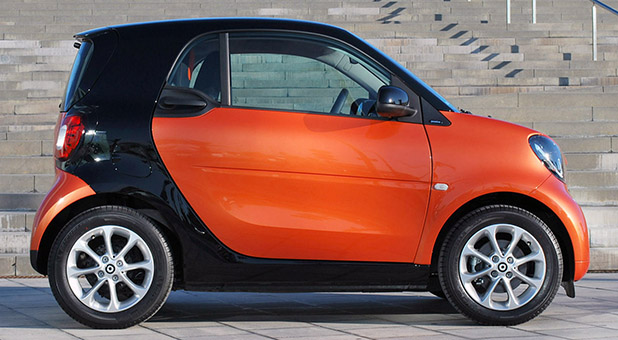
Without a doubt, the biggest question when it comes to replacing small cars is whether they should grow in size from one generation to the next. And when it comes to the new Smart Fortwo, the answer is both yes and no. Daimler has clearly paid careful attention to not make its new city car any longer than the tiny niche which the original carved out for itself. With the rubber already pushed out to the extremities, the Smart's wheelbase has hardly grown any, either. And with an already upright orientation, neither has its height. Where the new Fortwo has grown is in width. At 65 inches, the new model is roughly four inches wider than the one it replaces, which might make it a little trickier to slot perpendicularly between full-sized parked cars, but it delivers more stable cornering and a roomier interior.
Small as it is, the new Fortwo also looks more substantial than the Smart we've known until now. Part of that comes down to the relative dimensions that also make the new Fortwo four inches wider than it is tall, reducing the visual impression (justified or not) given by the outgoing model that it could topple over in hard cornering. The more planted look is completed by more substantial styling, with meatier lights, grille openings and contrasting Tridion safety cell. Whatever Daimler's styling department could visually beef it up, it seems, it did. So if the outgoing Smart looked to you like a folding chair on wheels, the new one may strike you more like a stable armchair, even though it's only actually grown in one dimension.
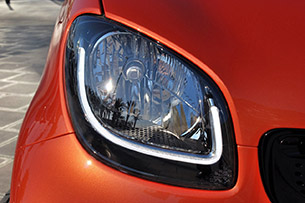
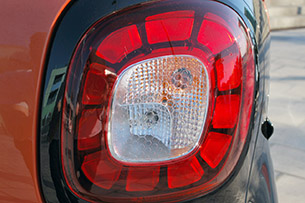
The latest-generation Smart has also clearly been designed to appeal to non-traditional buyers. With its safety cell, mirror caps, grille and wheels contrasting with the principal body color, the new Fortwo offers customers an array of 40 exterior color combinations to choose from and that's before interior options are even taken into account. Plastic body panels that reduce the prospect of dents and scratches also ought to make the Fortwo more appealing to urban dwellers who might otherwise scoff at the notion of owning a car.
Once squeezed into a tiny parking spot, though, the retention of the outgoing model's split tailgate ensures it's still easy to get at whatever you've got inside. There's even a storage compartment inside the lower portion of the tailgate itself for small items one of many steps Smart has taken towards making the best of an inherently small cabin. The optional panoramic glass roof fitted to our tester (a cabrio version is set to follow later) lent an airy feel to what could otherwise be a claustrophobic cabin, especially with the large rear pillars and oversized rearview mirror unfortunately obstructing outward visibility.
Our tester was also fitted with a seven-inch touchscreen (instead of the standard smartphone dock) that worked well along our route, as well as an optional adjustable tachometer/clock pod mounted atop the dashboard to the left of the standard TFT instrument display. We appreciated the supportive and adjustable seats, the sporty mesh dashboard trim, the spherical air vents and the simple climate controls that cleverly bridge the gap between cheap dials and costlier digital buttons with a magnifying glass sliding along a horizontal rule to set the desired temperature. Cargo capacity has increased incrementally as well, but a car as small as the Fortwo will still never be a top choice for hauling large items. However, Daimler claims a higher ratio of interior volume to exterior footprint than anything else in its diminutive class: measured from footwell to tailgate, the interior accounts for an impressive 75 percent of the car's length.
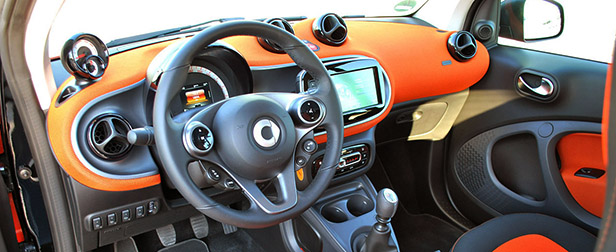
The optimized packaging is enabled, to a large degree, by the position of the engine. Both the Fortwo and Forfour were developed in tandem with the new Renault Twingo we drove recently the Fortwo will continue to be produced at Daimler's Smartville plant (ironically in France) with the Forfour to be built alongside the Twingo at Renault's plant in Slovenia. Like the outgoing Fortwo, the new models pack a tiny three-cylinder engine all the way in the back. In order to take up as little usable space as possible, Daimler and Renault engineers (who remain tight-lipped on the division of labor between them) canted the engine by 30 degrees, which necessitated a redesign of the cooling and lubrication systems to make sure water and oil still get to where they're needed despite the altered gravitational forces. Slotting the engine in the back also means more evenly distributed weight front to rear, and with more space for the steering rack up front, a tighter turning circle.
Europe and other markets will be offered a naturally aspirated engine displacing 1.0 liter that's available in both 59- and 70-horsepower states of tune, the latter roughly equating to the output in the current model. A more potent option displaces less at 898cc, but it's turbocharged to produce a more ample 89 hp. It's also got variable intake valve timing and an electronically controlled turbo wastegate. This is the only engine Daimler will offer in North America at least upon its launch here in the second half of 2015 but that's no bad thing. (An electric version will follow in 2016, and a more powerful Brabus version is under consideration.) Thankfully, gone is the much-maligned robotized manual transmission employed in previous iterations, replaced by a choice of a genuine five-speed manual or a new six-speed dual-clutch gearbox.
Our principal tester was equipped with the turbo engine and the five-speed, a combination which we found to be a sufficiently satisfying and zippy, a powertrain that adequately suits the size and mission of the vehicle. It may not be quite what we'd call "powerful", but the 27 percent more horsepower it produces does its part, and the 50 percent more torque makes all the difference.
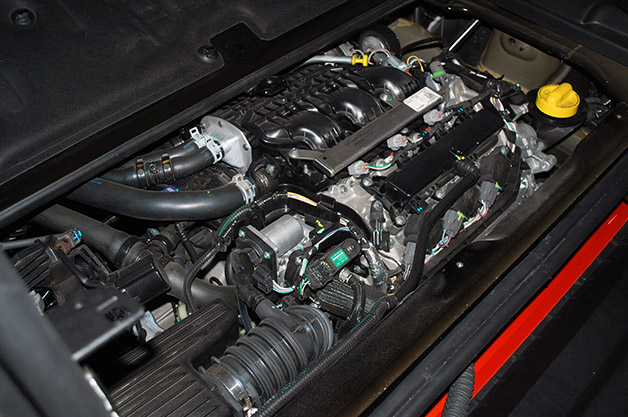
Although Daimler hasn't yet released full performance figures for each powertrain configuration (let alone US pricing and fuel economy figures), the five-speed turbo model is quoted to run 0-62 in 10.4 seconds, with a top speed of 96 miles per hour. That's a fair bit quicker than the model it replaces (12.8 seconds and 90 mph), not to mention the less-potent new version (15.9 seconds and 94 mph). A performance machine this is not, but then it's not designed to be one, either. Still, the turbo boost comes on at low revs to breath some life into the little machine, and the five-speed has a satisfyingly notchy feel to it, even if the clutch pedal has more travel than we'd like.
We also got a chance to sample an early development of the dual-clutch gearbox mated to the normally aspirated engine. Although the transmission seemed perfectly smooth in economy, standard and manual modes, we were let down by the lack of punch from the anemic engine and startled by the abrupt stop/start system. We wouldn't take too much stock in either, though, as the engine won't be offered in the US, and the gearbox (as emphasized by the powertrain engineers we spoke to) is still under development.
Daimler is also stressing the improved safety performance it's designed into the latest generation of Smart cars. More high-strength steel has been employed in the frame's construction to increase crashworthiness, but the new Fortwo has been equipped with more standard active safety features as well. The list of standard equipment includes crosswind assist, hill start assist, rear parking assist, tire pressure monitor and more airbags. There's also available forward collision warning and lane-keeping assist features you'd expect to find on a Mercedes S-Class (like the one with which Daimler crash-tested the new Fortwo) but not on a budget-oriented city car.
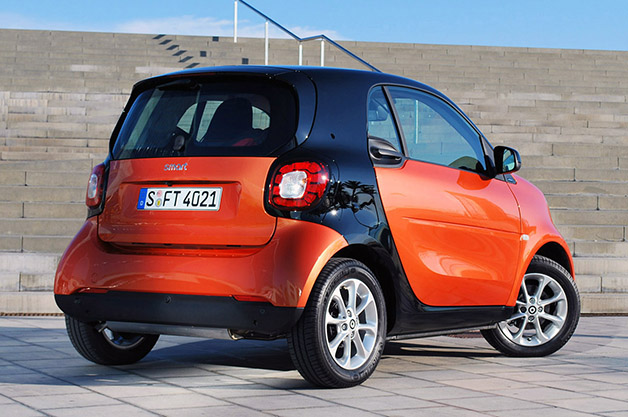
Where a Smart car really shines, naturally, is in its maneuverability. The outgoing Fortwo had a turning circle, wall to wall, of 28.7 feet. Despite being wider, the new Fortwo will turn around in a tight 24 feet better even than the iQ that until now claimed the tightest turning radius on the market. Though enthusiasts of the type unlikely to buy a Smart might lament the variable steering rack, Daimler asserts it further enhances the car's low-speed maneuverability. Either way, those figures translate to an exceptionally agile car to drive through the crowded city streets for which the Fortwo was designed.
With all these improvements in place, the new Smart Fortwo is undeniably a better vehicle than the one it replaces, one which will undoubtedly help Daimler stay ahead of the mounting competition. Whether it's good enough to help the Smart brand find profitability is an open question. And whether it's the right car for you, of course, will largely depend on where you live and how you intend to drive it. A car this small may not appeal, for example, to drivers in areas with wide-open highways, ample parking and affordable fuel. But for those living in densely populated metropolitan centers like Barcelona, Beijing, Tokyo or even Manhattan, it could make all the difference between owning a car or taking the subway. For providing those drivers with a better vehicle, we have to applaud Daimler and its smarter new city car.
http://www.autoblog.com/2014/11/10/2...-drive-review/
#2
Lexus Test Driver
EEK! Wow they botched that facelift. I honestly wish I never got the Smart ForTwo when they launched in in Canada many years ago. Funny thing is, I never drove it and when it was driven, there were issues. The only good thing about this car, is if you live in the city and you dislike parallel parking, it is so easy to fit in a spot.
#5
Moderator

Join Date: Aug 2006
Location: San Francisco, CA
Posts: 12,055
Likes: 0
Received 74 Likes
on
45 Posts
It makes no sense to buy this car if it doesn't get at least 40mpg. The current one is far from that number. I don't see why anyone would choose this over an efficient subcompact. Its not like the smart is cheap either
#6
Europe and other markets will be offered a naturally aspirated engine displacing 1.0 liter that's available in both 59- and 70-horsepower states of tune, the latter roughly equating to the output in the current model. A more potent option displaces less at 898cc, but it's turbocharged to produce a more ample 89 hp.

Trending Topics
#8
We now have tons of old ones around here - due to well known engine troubles, you can get 5-6 year old models for very cheap.
Thread
Thread Starter
Forum
Replies
Last Post





